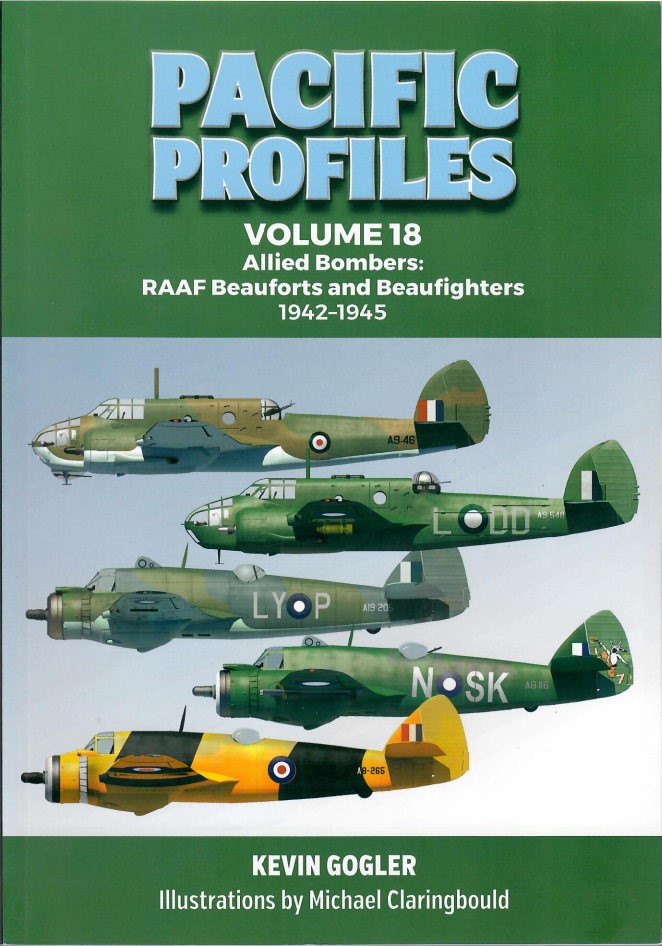Pacific Profiles, Volume 18 - Allied Bombers: RAAF Beauforts and Beaufighters 1942-1945
This is one of the rare Pacific Profiles books not written by Michael John Claringbould, although it is illustrated by him. Author Kevin Gogler is a son of a WWII Royal Australian Air Force (RAAF) Beaufort pilot, and this book is obviously a testament to his father and his fellow RAAF personnel who flew, and were associated, with the Beauforts and Beaufighters in the Pacific War.
From the Introduction:
“Amidst the enormous numbers of American aircraft that fought in the Pacific War, it is often forgotten that two British-designed types served operationally with the RAAF in large numbers. A combined total of some 1,280 Beauforts and Beaufighters were delivered to the RAAF and served with fifteen wartime squadrons plus a variety of training and support units.
From late 1942, both types were on the frontlines of the war with Japan. The Beaufort initially had a niche as a torpedo bomber, a role not otherwise undertaken by US Fifth Air Force squadrons in the New Guinea theatre. The Beaufighter found its own niche as a heavily armed low-level attack fighter and became a key component of Allied strike missions. Both types played important roles in the landmark March 1943 Battle of the Bismark Sea.
Subsequently, the Beaufort made its mark throughout Australia, New Guineas and the Netherlands East Indies as a light bomber, a maritime patrol aircraft and by undertaking numerous support activities. The Beaufighter also served across these theaters, often undertaking coastal sweeps to hunt Japanese barges. Later versions introduced the use of rocket projectiles by the RAAF.”
The book is a fascinating and remarkable insight into RAAF Beauforts and Beaufighters and their operations in Australia, New Guinea, and Dutch New Guinea and the Netherlands East Indies theaters, complete with extensive photographs and color profiles composing the following chapters and appendices:
- Contents
- Dedications
- About the Author
- Glossary and Abbreviations
- Maps
- Introduction
- Chapter 1 – RAAF Beaufort and Beaufighter Overview
- Chapter 2 – Building the Beaufort and Beaufighter in Australia
- Chapter 3 – Camouflage and Markings
- Chapter 4 – No. 100 Squadron
- Chapter 5 - No. 7 Squadron
- Chapter 6 - No. 14 Squadron
- Chapter 7 - No. 6 Squadron
- Chapter 8 - No. 8 Squadron
- Chapter 9 – Eastern Australia Beaufort Squadrons
- Chapter 10 – Northern Territory Beaufort Squadrons
- Chapter 11 - No. 15 Squadron
- Chapter 12 - No. 30 Squadron
- Chapter 13 - No. 31 Squadron
- Chapter 14 - No. 22 Squadron
- Chapter 15 – The Late Beaufighter Squadrons
- Chapter 16 – Training Units
- Chapter 17 – Other Units
- Chapter 18 – Postwar Service
- Chapter 19 – Disposal and Survivors
- Sources & Acknowledgements
- Index of Names
Beauforts and Beaufighters came in many camouflage patterns, including RAF Dark Green and Dark Earth over Sky Blue, RAF Dark Slate Grey and Extra Dark Slate Grey over Sky Blue, the same colors over Medium Sea Grey, RAAF Foliage Green and Earth Brown over Sky Blue, and finally standardized in overall RAAF Foliage Green was introduced in May 1944. The RAAF roundels began the war with a yellow outer ring. In September 1942, the RAAF deleted the red circle, overpainting the red with white, with the yellow ring having been overpainted previously; the red stripe on the fin flash was also deleted. Later, the white disc was increased in size from a ratio of 3:5 to 2:5. In 1948, the RAAF reverted to the standard RAF roundel until 1956 when the iconic kangaroo roundel was adopted. Two Beaufighters wore red kangaroos before their retirement.
Historians and modelers will gain a lot from this book. The photos and color profiles are worth the price of the book alone. The color profile section has great illustrations of all nineteen of the Pacific Theater’s Beaufort and Beaufighter squadrons serving in combat, training, communication, air supply, other missions, and postwar service, lasting until the final Beaufighter Mk XXI A8-357 was retired in November 1957. There is a lot of modeling inspiration within the 120 pages of this book. The Camouflage and Markings chapter is very impressive with how markings evolved, the camouflage colors and patterns, squadron codes for each airframe, stencils, and crew art. The big bonus is for modelers wanting unique paint schemes mentioned above and beautifully illustrated in the book. Anyone wanting to model a unique Pacific Theater Beaufort or Beaufighter will find plenty of examples, complete with the proper camouflage, markings, serial and squadron markings.
Postwar Beaufort service included aerial spraying to protect crops from bugs and locusts, target towing and special duties flights, research with the Council for Scientific and Industrial Research (CSIR), to include collecting airborne dust particles, high altitude flying in successful CSIR rain making experiments, radar tracking, brushfire patrols, and inflight missile recovery testing. The RAAF Beauforts and Beaufighters hold a special place in Australian aviation and the Pacific War fighting.
The Pacific Profiles series continues to fill large gaps in the South Pacific air war knowledge and history. Modelers are well served with this series, and inspiration runs wild with both the black and white period photographs and modern color profiles.
Profuse thanks to Casemate and IPMS/USA for providing the review sample
















Comments
Add new comment
This site is protected by reCAPTCHA and the Google Privacy Policy and Terms of Service apply.
Similar Reviews